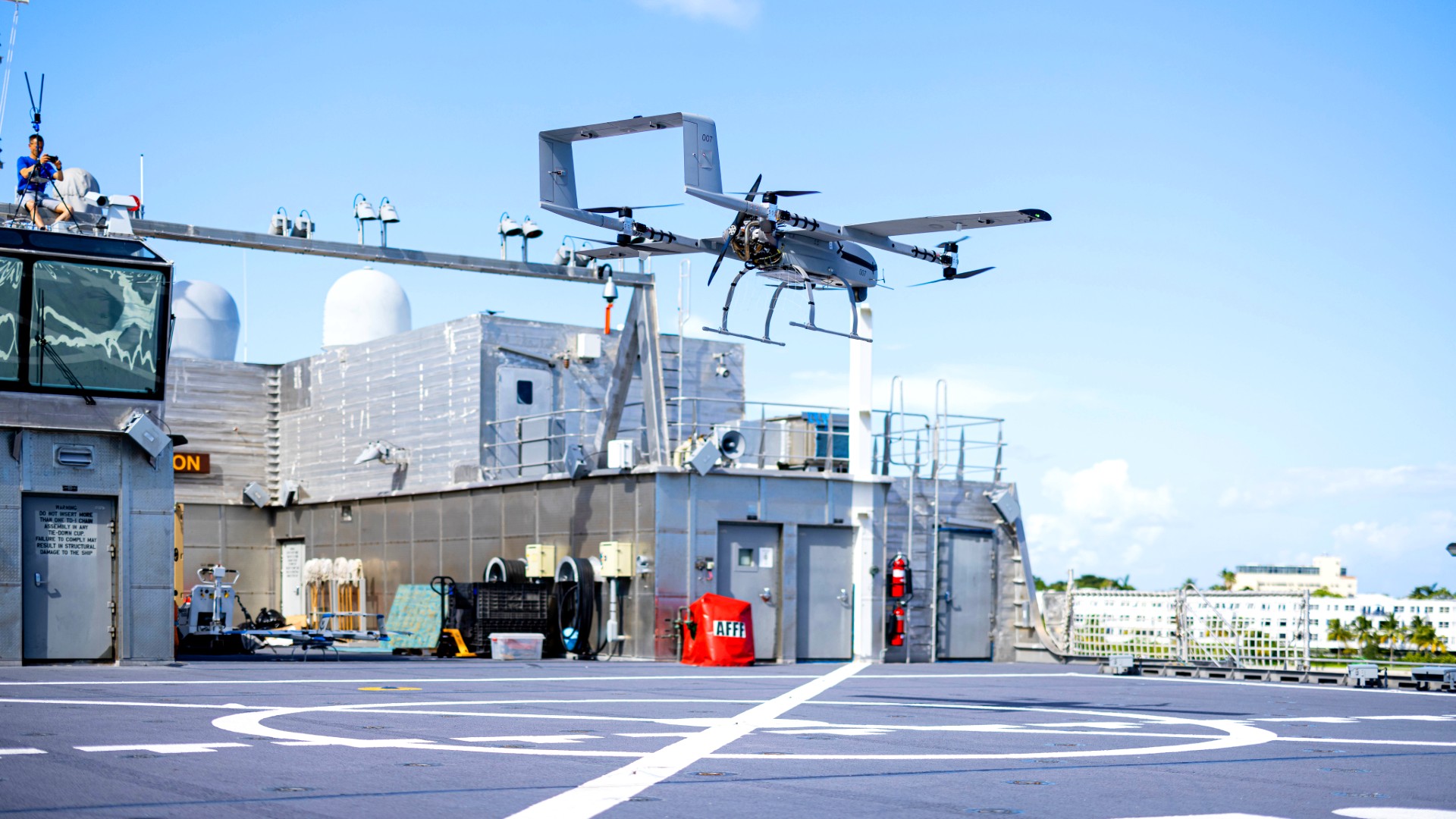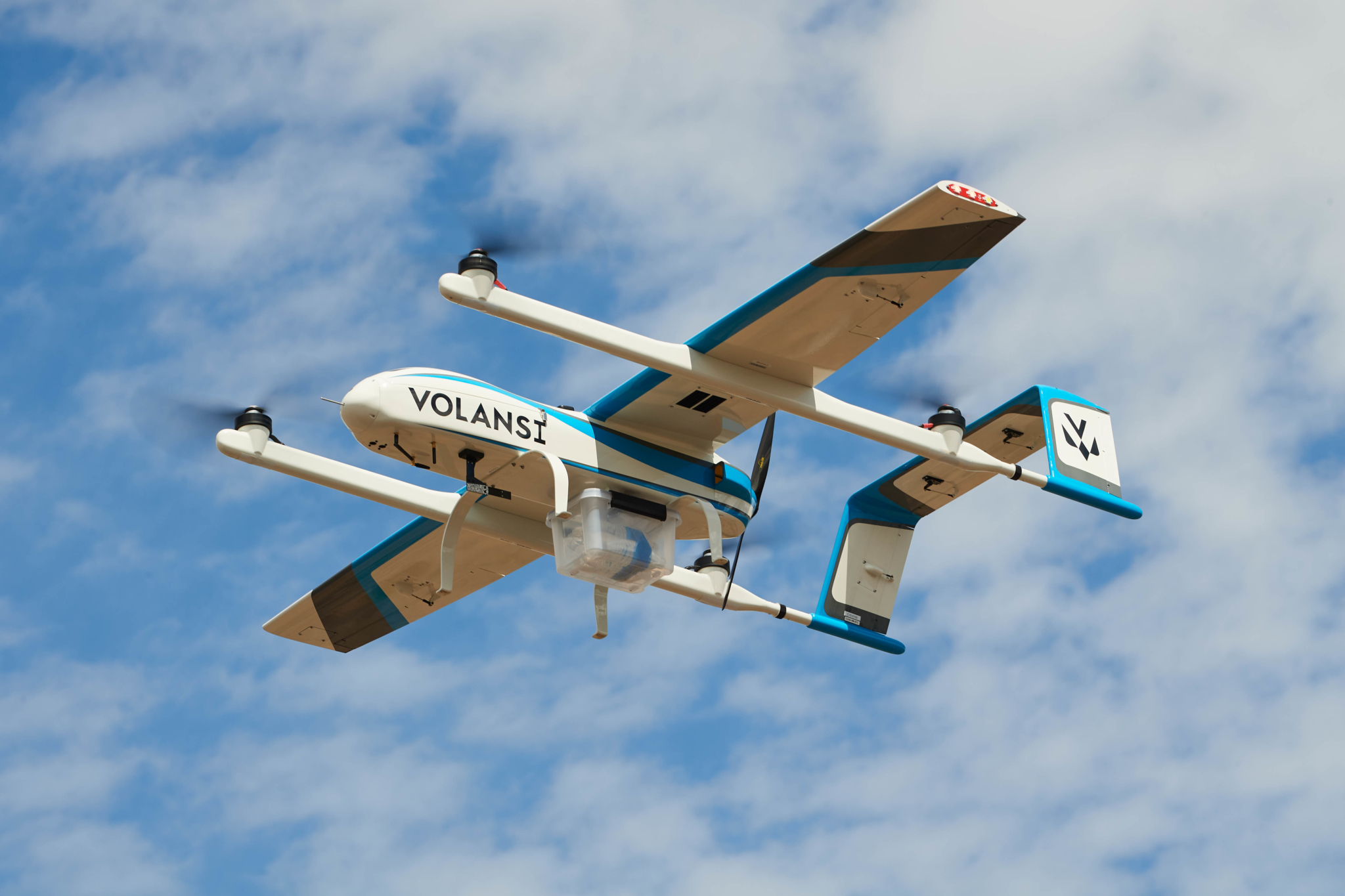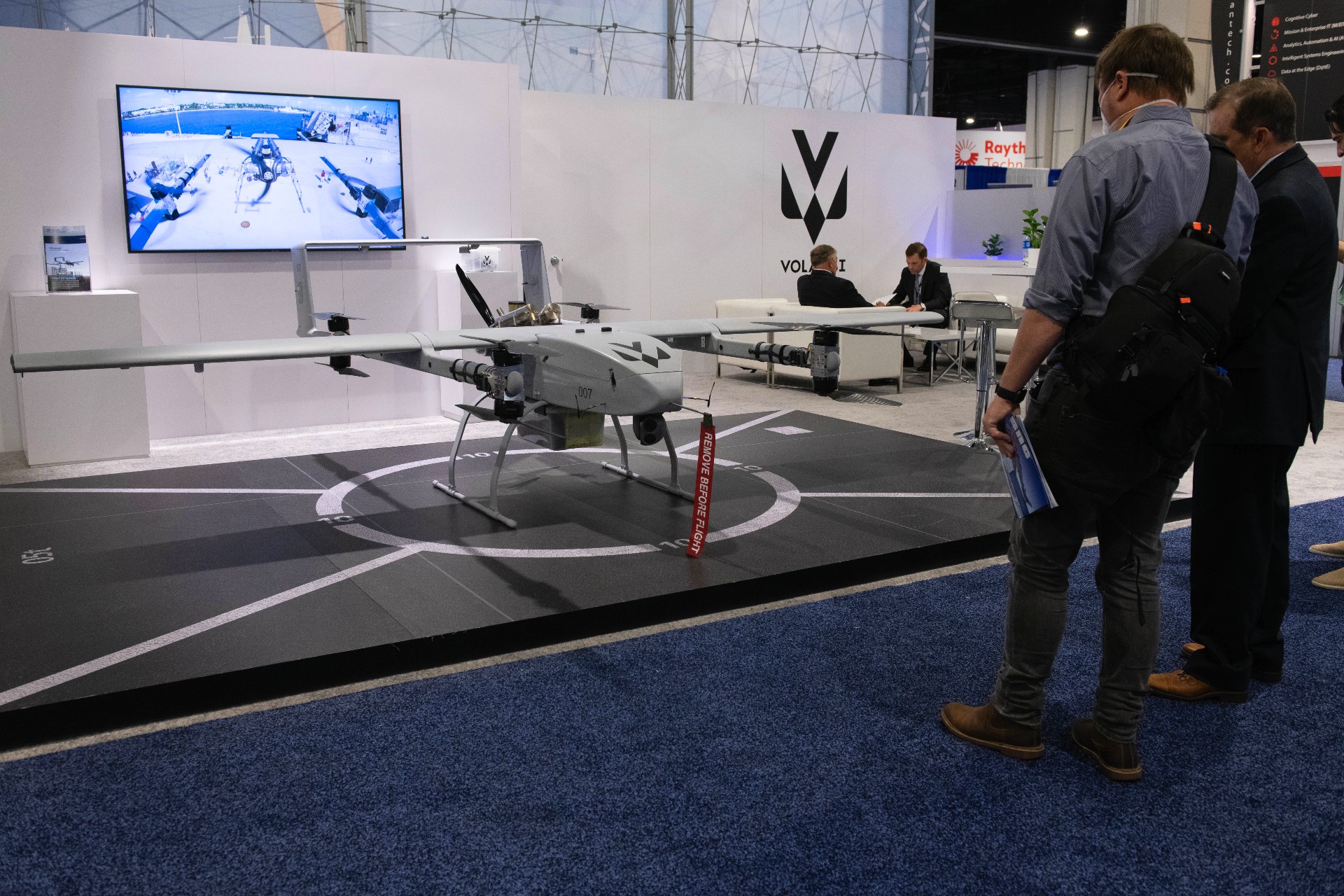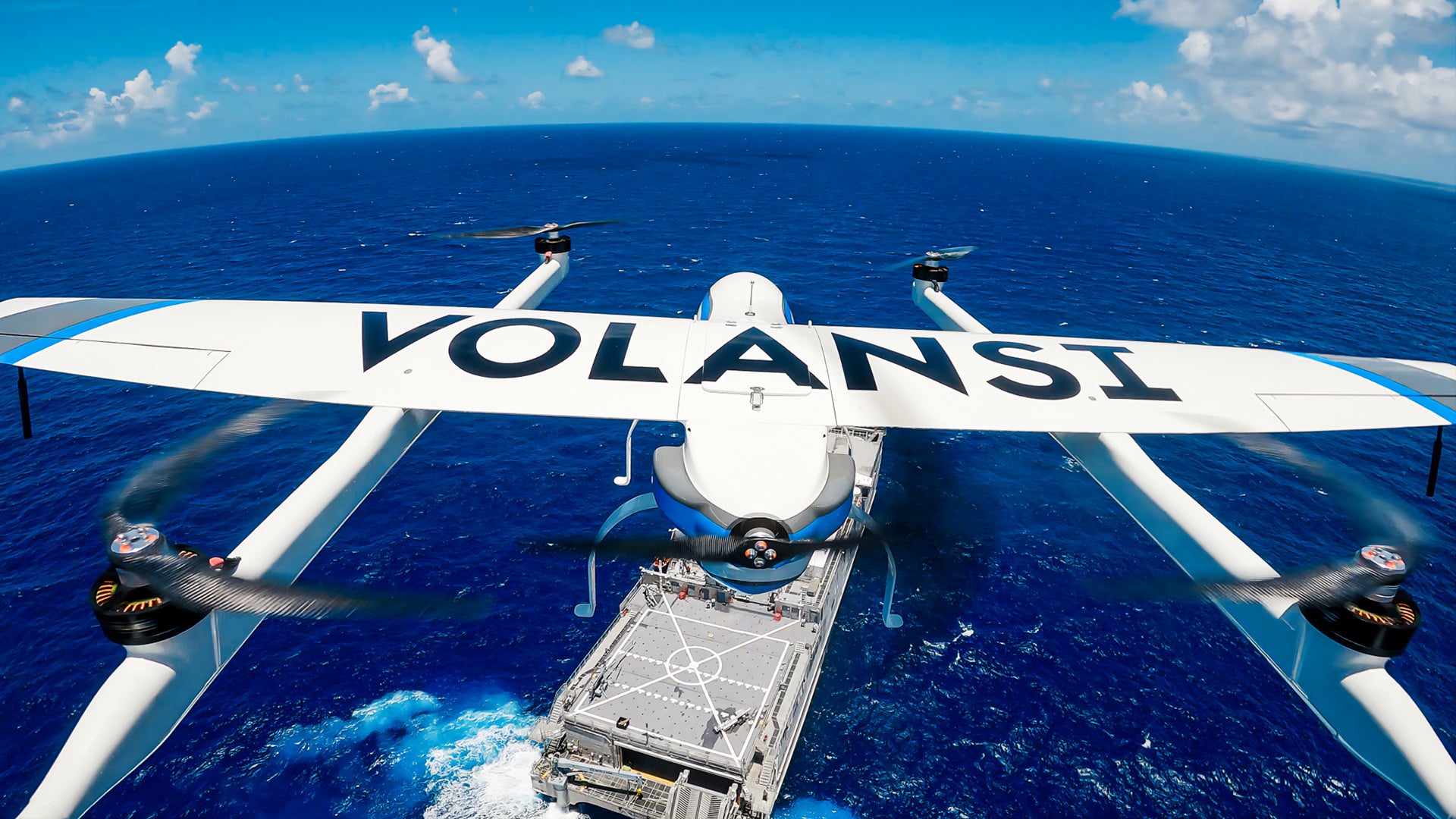Drone manufacturer Volansi has announced it has completed the first-ever autonomous ship-to-ship drone deliveries. In the demonstration, two vertical takeoff and landing-capable unmanned aircraft made three successful deliveries between a U.S. Navy ship and a U.S. Coast Guard vessel off the coast of Key West, Florida, marking a milestone in the Navy’s recent push for new unmanned logistics concepts to support its fleets.
According to Drone DJ, Volansi says the deliveries mark the “first time ever that an autonomous drone has carried out such missions, carrying cargo between two moving US government vessels.” The deliveries were made by two separate Volansi models: the VOLY C10, capable of carrying payloads up to 10 pounds within a range of 42 miles and the VOLY M20, with a cargo payload capacity of 20 pounds, a range of 350 miles, and a top cruising speed of 75 miles per hour. The M20 can also carry a sensor payload weighing up to 10 pounds in addition to its cargo.

Both models feature the same general layout, with a center fuselage suspended under a main wing and twin-boom configuration. A single pusher prop provides forward thrust in level flight for both the C10, which is all-electric, and the M20, which has a gasoline-powered main engine. Both types then also have a pair of small lift rotors installed on each boom, one in front and one behind the wing, for vertical takeoffs and landings.
The VOLY C10 conducted two flights, flying 15 miles from a Spearhead class Expeditionary Fast Transport, or EPF, belonging to Military Sealift Command (MSC), to the Sentinel class cutter USCGC William Trump and back. The VOLY M20 took off from the Military Sealift Command ship and flew just one nautical mile, in 20 mile per hour winds, to a small Coast Guard skiff before returning to the Navy vessel.
Volansi recently appointed Former Assistant Secretary of the Air Force for Acquisition, Technology and Logistics Will Roper to CEO after he joined the company just four months prior. Roper says that this recent autonomous delivery “signals a bright future for autonomous cargo delivery” and added that the deliveries were made using a single ground control station. The company is now working towards developing platforms capable of carrying heavier payloads and longer endurance.

Drone delivery concepts specifically have been explored by the U.S. Navy in recent years. In 2020, a small UAV was tested for use in replenishing Ohio-class submarines while they are at sea on nuclear deterrent patrols. In that demonstration, the drone was remotely piloted by a crew of two.

A similar 2021 demonstration saw an autonomous drone carry equipment between the Mid-Atlantic Regional Maintenance Center (MARMC) at Naval Station Norfolk and the USS Gerald R. Ford while it was docked there. In a press release issued after the successful delivery, USS Gerald R. Ford’s commanding officer Capt. Paul Lanzilotta added that “Carrier logistics is a complex and diverse problem set” and that “Sometimes getting a small part delivered to the ship has a big impact on the availability of an embarked system or aircraft.”
While the payloads of the VOLY drones sound small, small is sometimes what is needed most. The same press release claims that Navy data shows that warships placed on “non-mission capable” or “partially mission capable” status often do so due to minor logistical concerns, 90 percent of which can be remedied through deliveries weighing less than 50 pounds. Currently, these deliveries are made by Marine Corps MV-22 Osprey tiltrotors or the Navy’s own MH-60 Seahawk helicopters. Obviously, the fuel and operating costs of these aircraft are much higher than those of small drones that can accomplish the same deliveries. Also, these aircraft have other important tasks to perform.

Small VTOL drones like the Volansi models offer advantages when delivering cargo to small ships or submarines that lack a dedicated flight deck and can’t accommodate larger platforms. Additionally, platforms like the VOLY drones could be very valuable in future operations where traditional logistics support might be hard to come by. Contested logistics, or ensuring forward-deployed units are stocked with fuel and other supplies no matter where they are operating, has become a cornerstone of the Joint Chiefs’ new “Expanded Maneuver” concept, and it’s likely that autonomous unmanned deliveries could play a role within this framework in the future.
In addition, using multiple small drones to make deliveries can fit into a larger concept of distributed operations, allowing larger, more traditional assets to bring large amounts of supplies to forward operating bases at which point fleets of cargo drones can distribute the cargo to more geographically widespread units and assets.
Given previous Navy experiments with drone deliveries, it’s safe to say that these same autonomous platforms could be used for ship-to-shore applications (or vice versa). In addition, it’s likely that other services could be interested in the same capabilities.
After its recent successful demonstration, Volansi issued a press release claiming that the company’s VTOL drones are well-suited for remote locations and austere environments thanks to “runway independence, a small operational footprint and, on some platforms, the ability to carry cargo and sensors simultaneously,” Drone DJ reports. Those specific capabilities have been a large part of the U.S. Air Force’s recent push for being able to operate from austere bases in forward operating areas without existing military infrastructure. Both the U.S. Army and the United States Marine Corps have also tested similar concepts for unmanned cargo drones in recent months
These recent experiments in Volansi’s drone delivery concepts show that much like the rest of the Navy’s operations, logistical missions could be handled at least partially by unmanned systems in the near future.
Contact the author: Brett@TheDrive.com
